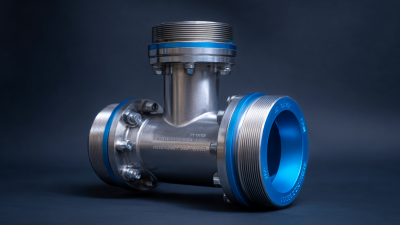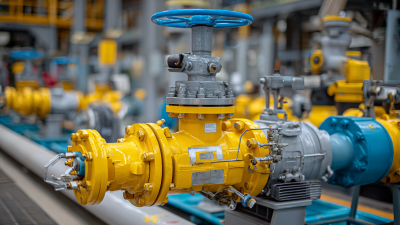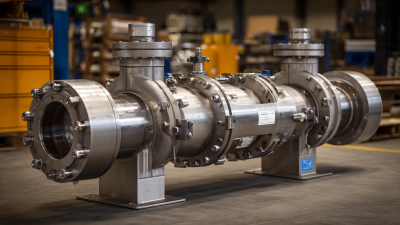5 Essential Tips for Choosing the Right Lined Valves for Your Industrial Needs
In the world of industrial applications, the selection of appropriate components is
critical for operational efficiency and safety, especially when dealing with
corrosive substances. According to a recent report by MarketsandMarkets,
the lined valves market is projected to reach $3.4 billion
by 2025, reflecting a growing demand for reliable solutions in sectors such as chemical processing,
oil and gas, and wastewater management.
 Lined valves, designed to withstand harsh environments and prevent leakage, play an essential
role in ensuring the integrity of industrial systems. However, with numerous options available,
choosing the right lined valves can be a daunting task for engineers and procurement professionals.
This blog provides five essential tips to navigate the complexities of selecting lined valves
that best meet your industrial needs, ensuring both performance
and longevity in challenging conditions.
Lined valves, designed to withstand harsh environments and prevent leakage, play an essential
role in ensuring the integrity of industrial systems. However, with numerous options available,
choosing the right lined valves can be a daunting task for engineers and procurement professionals.
This blog provides five essential tips to navigate the complexities of selecting lined valves
that best meet your industrial needs, ensuring both performance
and longevity in challenging conditions.
Understanding the Different Types of Lined Valves Available for Industries
When it comes to industrial applications, selecting the right lined valves is crucial for ensuring operational efficiency and safety. Lined valves are designed to handle corrosive materials and extreme temperatures, making them an essential component in various industries such as chemical processing, oil and gas, and wastewater management. Understanding the different types of lined valves is vital to making an informed decision.
There are several types of lined valves available, each tailored to specific applications and environments. For instance, fluoropolymer-lined valves offer excellent chemical resistance, making them ideal for handling aggressive substances. On the other hand, rubber-lined valves are more suitable for moderate corrosive environments and provide good sealing properties. Additionally, it’s important to consider the valve body materials, as they can affect durability and compatibility with the fluids being handled. By evaluating the unique requirements of your industry and the specific characteristics of each valve type, you can select the most appropriate lined valve to meet your operational needs effectively.
Key Factors to Consider When Selecting Lined Valves for Specific Applications
When selecting lined valves for specific industrial applications, there are several key factors to consider to ensure optimal performance and longevity. First, the chemical compatibility of the lining material with the media being handled is crucial. Different materials, such as PTFE, PFA, or rubber linings, offer varying levels of resistance to corrosive substances, temperature variations, and pressures. Evaluating the operational environment will help determine the ideal lining that can endure these conditions without degrading.
Another important factor is the valve design and flow characteristics. Depending on the application, the flow rate and pressure requirements can significantly influence the type of valve needed. For instance, throttling applications may require different configurations compared to those needing full flow. Additionally, considering maintenance and accessibility is vital; selecting valves that offer easy disassembly or have fewer components can simplify repairs and reduce downtime in industrial operations. By prioritizing these factors, you can select the right lined valves that will meet the specific demands of your application effectively.
| Tip | Description | Key Applications | Material Compatibility |
|---|---|---|---|
| 1. Understand the Lining Material | Choose a lining material that is compatible with the fluid being transported. | Chemical processing, Pharmaceuticals | PTFE, Rubber |
| 2. Assess Pressure and Temperature Ratings | Ensure the valve can handle the specific pressure and temperature conditions of the application. | Oil & Gas, Water Treatment | Steel, Nickel Alloys |
| 3. Evaluate End Connections | Select valves with end connections that fit the existing plumbing system. | Pulp & Paper, Food & Beverage | PVC, Flange |
| 4. Review Maintenance Requirements | Consider the maintenance and servicing needs of different valve types. | Mining, Power Generation | Cast Iron, Alloy Steel |
| 5. Check Certifications and Standards | Ensure the valves meet industry standards and certifications for quality. | Pharmaceuticals, Electronics | API, FDA Compliant |
Common Challenges and Problems with Lined Valves and How to Overcome Them
When it comes to industrial applications, lined valves are crucial for ensuring optimal performance and durability. However, users often face common challenges that can impede their effectiveness. One significant issue is the potential for damage to the lining caused by abrasive media or high-pressure conditions. To mitigate this risk, it's essential to select valves with linings made from robust materials like PTFE or polyurethane, specifically designed to withstand such conditions.
Another frequent problem is the difficulty in achieving a proper seal. Poor sealing can lead to leakage and reduced efficiency, impacting the overall operation. To tackle this, opt for lined valves with advanced sealing technologies and ensure proper installation to eliminate gaps that could compromise the seal. Regular maintenance is also vital, as wear and tear can degrade the performance of the lining over time. By addressing these challenges with thoughtful selection and proactive maintenance, industrial operations can harness the full benefits of lined valves, leading to enhanced reliability and longevity in their systems.
5 Essential Tips for Choosing the Right Lined Valves for Your Industrial Needs
This chart illustrates the importance of various factors when selecting lined valves for industrial applications. High ratings in chemical resistance and temperature tolerance indicate their critical role in ensuring the reliability and effectiveness of the valves in challenging environments.
Importance of Material Compatibility in Choosing Lined Valves
When selecting lined valves for industrial applications, material compatibility is a critical factor that cannot be overlooked. The right choice ensures not only the efficiency of fluid handling but also the longevity of the components in various operating conditions. Understanding the properties of the materials used in both the valves and the lining can greatly reduce the risk of chemical reactions, leading to failures or leaks that can be costly and dangerous.
One essential tip is to thoroughly assess the chemical composition of the fluids being transported. Different materials have varying resistance to corrosive substances; therefore, it's vital to match the valve lining with the fluid characteristics. Another consideration is the operating temperature and pressure, which can affect the performance of the lining materials. Utilizing standards and guidelines specific to your industry can provide additional assurance that the materials will endure the demanding conditions.
A final key point is to evaluate the expected lifecycle of the valves. Investing in high-quality materials that are compatible with both the application and the environmental factors will pay off in terms of less frequent replacements and lower operational costs. By prioritizing material compatibility from the outset, you can ensure a more reliable and efficient industrial operation.

Maintenance Tips for Ensuring Longevity of Lined Valves in Industrial Settings
When dealing with lined valves in industrial settings, maintenance plays a crucial role in ensuring their longevity and reliability. Regular inspection of the valve body and its lining is essential. Look for signs of wear, corrosion, or damage, as these can lead to leaks and compromised functionality. Employing a routine maintenance schedule, including cleaning and servicing, will help identify any issues before they escalate, preserving the integrity of your valves.

Additionally, the choice of materials and the working conditions are significant factors in the lifespan of lined valves. For instance, using stainless steel or cast steel can enhance durability, especially in demanding environments such as oil and gas industries. It’s important to match the valve type, whether ball valves or globe valves, with the specific requirements of your application, optimizing performance and reducing wear over time. Proper installation and adherence to the manufacturer’s guidelines also contribute to the overall performance and longevity of lined valves, ensuring they function effectively in various industrial applications.
Related Posts
-

Mastering BFV Valves: A Comprehensive Tutorial on Selection, Sizing, and Optimization Techniques
-

Unmatched Excellence in PTFE Lined Check Valves: Crafted in China, Delivered Worldwide
-

Understanding Industry Standards for the Best Actuator Valve and How to Choose the Right One
-

Mastering Ball Valve Selection: A Comprehensive Tutorial for Optimal Flow Control in Industrial Applications
-

Understanding the Benefits and Applications of Lockable Ball Valves in Industrial Settings
